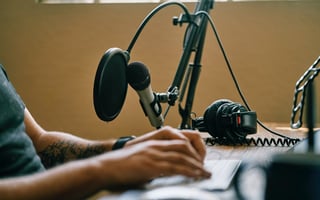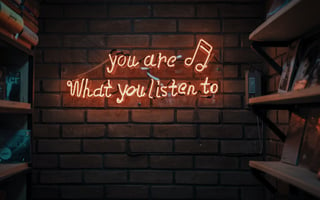Podcasts are going from strength to strength. There are now more than a million active podcasts and...
Podcasts are booming and businesses are turning to them to add variety and bring a human voice to their content and brand.
There are now more than four million podcasts registered around the world.
And there are around 19 million podcast listeners in the UK, with predictions suggesting this will soar to 28 million by 2026.
Globally, there are 400 million podcast listeners engaging with different content.
So, isn’t it time your organisation got involved?
The latest masterclass for members of The Media Team Academy explored how you can get started in podcasts.
Our managing director James White was joined by Tom Idle, an experienced podcast host, to explore everything your need to know about making a branded podcast – you can watch the session here.
Tom launched his first podcast in 2016 and has worked with us on creating podcasts for our clients.
“I got addicted to podcasts early and thought I could do them for myself, he said. “I learnt how to do it on my own using the software on my laptop.
“But I think I over-committed by deciding to do a weekly podcast. We ran for 18 months and ran out of steam a bit.
“It was incredibly resource intensive and was a tough gig.
“One of the best bits of advice I had when I first launched was to record a whole bunch of episodes and launch them all at once in the hope the audience would latch on to it and not think that it was a one-off.”
So, should your organisation follow Tom’s lead and create its own podcast? Or is it better to be a guest on a podcast?
“There are pros and cons to both,” Tom said.
“There are some great podcasts out there you can get involved with and be a guest on. They have a ready-made audience, and it is quick and efficient to do.
“But investing in your own podcast has loads of benefits. You have control. You can start building your brand. You can use it for sales and marketing.
“But it is tricky and requires investment.”
James added: “One consideration is you may already have a bit of a captive audience.
“We have a decent following on our blogs, and one of the things we have done recently is to record them and launch them on our podcast. It has helped us reach a new audience.
“And I think that is a nice way of testing whether your audience is interested in audio.”
Tom believes it is crucial to remember podcast audiences engage with content differently.
“People listen to podcasts when they are not working, whereas most corporate content is looked at on the fly while you are working at your desk.
“But with podcasts, you are in the gym, the kitchen, the car, and you are in a different mindset and are engaging that much more.”
Tom has helped create podcasts for several of our clients, including Sagentia Innovation, Frontier Economics and Wrap.
How has he found that process?
“You have to work out what the objective is and what they want to achieve.
“And then it is about the planning process. What are their key messages? What do they want to get across? And working out different formats for them.
“So, a lot of the time is spent in the planning phase, and then the execution, recordings and edits are the easy bit.”
To put that in context, Tom believes around 90 per cent of the time spent on podcasts goes into the planning.
“There is so much you need to do upfront to ensure you hit the right messages,” he added. “You have to storyboard and think about how you are going to get from A to B to C through that podcast, make sure you are clear on the messages and narrative and then be clear on the format so it comes across in a way that hits the brand and the strategy of the client.”
What makes good podcast content?
If you’ve been on one of our media training courses, you will be familiar with the acronym TRUTH, which shows what makes something newsworthy.
And it applies to podcasts.
It means content should be:
Topical: Something that is interesting to people at the moment. Maybe something that is trending or is being widely discussed. Podcast content can be evergreen, but the best-performing podcasts have topical and timely content.
Relevant: This is about understanding your audience and how you can be relevant to them. With podcasts, you can afford to be niche.
Unusual: What can you offer that is a little bit different?
Trouble: Are you solving a problem people are experiencing?
Human: People are fascinated by stories about other people.
James said: “The more of this TRUTH content you get into your podcast, or that your spokespeople get into a podcast they appear on, the more interesting it will be for listeners.”
Being niche is also crucial.
“Don’t be afraid to embrace the niche,” Tom said. “Podcasting is not about chasing audience figures and going mainstream. So, you can be as niche as you want, and the audience will find you.”
The importance of having a repeatable format
James believes creating a repeatable format is vital for successful podcasts.
“One of the best bits of advice I’d give to anyone looking to create their own podcast is to develop a format they can repeat.
“It might be that means you have an interview section where you chat with a guest for 10 minutes, but always have it in the same place each episode.
“You may have a five-minute product showcase, to give another example. Always have it in the same spot.
“Treat your audience like drunks – signpost things for them. People don’t listen to podcasts in the same way they watch TV – they tend to be doing something else at the same time. So, you need to tell them what is coming up and what you will show or teach them.”
Tom agrees.
“We all like familiarity and routine,” he said. “So, creating that formulaic structure is helpful for the audience, not just the people producing it.
“When it feels familiar, and people know where they are, it builds loyalty and trust.
“My The Better Business Show podcast was very formulaic. I’d start with a five-minute monologue introducing the subject, then I would go to a pre-recorded interview on the subject, and at the end, I would bring in one of my journalist friends, and we would chat about what was in the news that week.”
A typical podcast format would look something like this:
- A few seconds of music
- Presenter introduction
- Montage of interviews
- Into the main interview
- Signposting for new chapters
To put that into more context, the first series of our The Media Landscape podcast – where each episode was 15 minutes - had a 90-second introduction, a headline news item that was around four minutes, two further news items lasting about two minutes each, a feature interview with a journalist lasting five minutes and 30 seconds of outro and credits. Among that, there were music, adverts and stings.
Assets
You may not be familiar with the term ‘stings’. These are one of the media assets that can be added to podcasts in the post-production stage.
Darren Wingham, from our studio team, joined the masterclass to explore this in more detail.
Montages
“These are those bursts of energy that create the fear of missing out at the start. Montages are your most exciting clips, that don’t give listeners everything, but tease them so they want to learn more. You also see them used on the news.”
Music beds
“Underneath the montage, you will hear music. Music beds are vital because they create emotion. And it sets the tone of your podcast.
“So, to get this right, think about who it is for and your brand. Music for a fizzy drink, for example, is different from the music you would choose for expensive perfume.
“The good news is there is lots of library music to choose from, and it is budget-friendly.
“Once you have chosen the right music, find the best 20 seconds and loop it.”
Stings and jingles
“This goes back to thinking of people being drunk. It is a brilliant way of grabbing their attention by highlighting that something else is about to start.
“Normally, we take a five-second bit of the music we already have and use it as a sting.”
Credits
“You might wonder why we have them. But mentioning everyone involved is a subtle way to humanise your company.”
Adverts
“When people are listening to a podcast, you have their attention. Don’t waste that opportunity. Think about what you would like to promote to them and what you can get them to do. Keep it succinct and interesting. Sell the benefits of your product or service rather than the product or service itself.”
What kit do you need for podcasts?
“The first and most important thing when it comes to kit is a decent microphone,” James said.
“They don’t cost loads of money. But expect to spend around £140 on a decent one.
“And, ideally, ensure all your guests have the same microphone - it will help with audio quality and consistency.
“You also need something you can record on to. Don’t record the audio on Zoom or Teams because they compress the audio quality, and it doesn’t sound as crisp. It makes the editing and post-production stage much harder.
“When we record remotely, we send people USB microphones they can plug into their computer and then send back to use after recording.”
In terms of software, James recommends Riverside FM, a sort of online recording studio.
“It allows you to record audio remotely without the audio being compressed,” he said.
“It records audio locally and then uploads it to a central cloud where it can be downloaded.”
Trint is another bit of software we use in podcast production.
“Trint transcribes your audio,” James said. “You upload audio to it, and it transcribes it, breaking it down by different speakers.
“In terms of editing software, Audacity is good – and free. It is also non-destructive, which means if you edit something out, it won’t delete it - it sort of hides it. And that means you can get it back if you need it.”
What about for uploading podcasts to Apple iTunes or Spotify?
“We recommend something like Buzzsprout,” James said. We use it, and it is easy. You create your show in there, and you can select the channels you send it to.”
How long does it take to edit a podcast?
Well, it is a time-consuming process.
“It can be sped up with good planning,” Tom said.
“But the nature of the beast is that what you need from your guests are good stories, and it is down to presenters and producers to get them out of people – and that can take a few goes.
“So, there is always going to be an editing process.”
James uses something he refers to as “the two-day editing process.”
“Once you have got the audio, the first thing you do is clean it. We outsource this to another company, and they remove any sirens, hums and air conditioning noises and make sure the levels are right.
“When that’s done, we have a first listen and do a paper edit on Trint - we look at the storyboarding and narrative and check it all makes sense and meets the objectives.
“We then have a second listen. And with Trint, you can highlight a section and see what it sounds like without that part. And you can time-stamp it so you can tell the editor the parts you want taken out.
“You would then record the presenter links.
“This is followed by a third listen where you hone it further.
“And the final things that go in are the music beds and stings. We finish with a final listen with new people.”
What is the ideal length for a podcast?
It is a question that comes up a lot.
And although length matters, the answer is not definitive.
But around the 40-minute mark is a good guide.
“We find 40 minutes is ideal,” James said. “The evidence suggests that is a good time.
“And I think it works well with typical commutes. If you have a 20-minute commute, you can listen on the way there and back. You can probably listen to the episode in one go if you have a longer commute."
Tom added: “I think it depends on your audience and how much time they have. Some podcasts are playing around with timings. I’m a big fan of The Diary of a CEO – Steve Bartlett’s podcast. He has just started extending to about 90 minutes, and I suspect he has an impressive team behind him, crunching the data to say that is about right.”
How do you measure the success of a podcast?
In the world of comms, you are never too far away from a measurement question.
And you need to see a reward for your effort – but that reward will vary.
“It depends on what you want to achieve,” James said.
“With our podcast, I’m not worried about listener numbers. I don’t mind how many people listen.
“But I want people to get value out of it and then become engaged with the rest of our brand. So, I’m looking for people to listen to our podcast and then hop on to our blogs and eBooks and sign up to our marketing list.”
It is also crucial to remember you can reuse the podcast content in other ways – “sweat the asset”, as James said. Turn your podcast into an eBook, blogs, and social media posts.
What’s the difference between preparing someone for a podcast interview and a media one?
There are similarities. But the crucial differences are around answer length and storytelling.
Tom said: “If someone has done lots of media interviews, you tend to find their answers are quite clipped and to the point.
“But with podcasts, you want them to open up more. It is a different medium. You want them to be relaxed and tell stories. They don’t need to get to the heart of the point in the first couple of answers.”
James added: “I think the skills are the same, but you need to adjust them to a different audience and format.”
Should you record a video of your podcast and put it on YouTube?
This is something that is happening increasingly often. You’ll see them pop up in social media feeds.
“I think it definitely works with a younger demographic,” James said. “They are more likely to watch a podcast.
“There is no reason why you can’t do both, and I think it is something we will see more of.”
To sum up the session, James and Tom offered their nine top podcasting tips.
- Be niche – don’t worry about listener numbers
- Aim for 30 to 45 minutes
- Stick to one podcast host
- Brief spokespeople (but don’t overprepare)
- Be flexible with your storyline
- Focus on audio and content quality
- Come up with a repeatable process and format
- Be consistent with uploads
- Don’t try and do it all yourself
Want access to more sessions like this? You must be a member of The Media Team Academy - our learning and development programme – designed specifically for comms and media teams.
For just £795 + vat, you can attend sessions like this, have unlimited access to our online courses and benefit from comms clinics with our expert tutors. Learn more by clicking here or speaking to your account manager.
Like the sound of our podcast production services?
Whether you are at the beginning of your podcast production or need help with the audio editing and post-production needed to make a quality podcast, we can help.
Chat with your account manager about your podcast production needs and ambitions.




